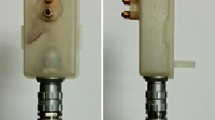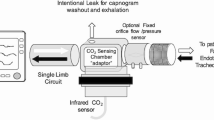Abstract
Continuous respiratory gas monitoring is an important tool for clinical monitoring. In particular, measurement of respiratory \(\hbox {CO}_2\) concentration and gasflow can reflect the status of a patient by providing parameters such as volume of carbon dioxide, end-tidal \(\hbox {CO}_2,\) respiratory rate and alveolar deadspace. However, in the majority of previous work, \(\hbox {CO}_2\) concentration and gasflow have been studied separately. This study focuses on a mainstream system which simultaneously measures respiratory \(\hbox {CO}_2\) concentration and gasflow at the same location, allowing for volumetric capnography to be implemented. A non-dispersive infrared monitor is used to measure \(\hbox {CO}_2\) concentration and a differential pressure sensor is used to measure gasflow. In developing this new device, we designed a custom airway adapter which can be placed in line with the breathing circuit and accurately monitor relevant respiratory parameters. Because the airway adapter is used both for capnography and gasflow, our system reduces mechanical deadspace. The finite element method was used to design the airway adapter which can provide a strong differential pressure while reducing airway resistance. Statistical analysis using the coefficient of variation was performed to find the optimal driving voltage of the pressure transducer. Calibration between variations and flows was used to avoid pressure signal drift. We carried out targeted experiments using the proposed device and confirmed that the device can produce stable signals.







Similar content being viewed by others
References
Bates J, Schmalisch G, Filbrun D, Stocks J. Tidal breath analysis for infant pulmonary function testing. ers/ats task force on standards for infant respiratory function testing. european respiratory society/american thoracic society. Eur Respir J. 2000;16(6):1180–92.
Berggren M. Improved response time with a new miniaturised main-stream multigas monitor. JCMC. 2009;23(6):355–61.
Cinar O, Acar YA, Arziman İ, Kilic E, Eyi YE, Ocal R. Can mainstream end-tidal carbon dioxide measurement accurately predict the arterial carbon dioxide level of patients with acute dyspnea in ed. AJEM. 2012;30(2):358–61.
Jaffe MB, Orr J. Continuous monitoring of respiratory flow and CO2. IEEE Eng Med Biol Mag. 2010;29(2):44–52.
John RES. End-tidal carbon dioxide monitoring. Crit Care Nurse. 2003;23(4):83–8.
Kuhn K, Pignanelli E, Schutze A. Versatile gas detection system based on combined ndir transmission and photoacoustic absorption measurements. IEEE Sensl J. 2013;13(3):934–40.
M. Pekdemir, O. Cinar, S. Yilmaz, E. Yaka, M. Yuksel, Disparity between mainstream and sidestream end tidal carbon dioxide values and arterial carbon dioxide levels. Respir Care. respcare–02227 (2013)
Sotnikova GY, Gavrilov GA, Aleksandrov SE, Kapralov AA, Karandashev SA, Matveev BA, Remennyy MA. Low voltage co-gas sensor based on iii–v mid-ir immersion lens diode optopairs: where we are and how far we can go? IEEE Sens J. 2010;10(2):225–34.
Xie Q, Li J, Gao X, Jia J. Fourier domain local narrow-band signal extraction algorithm and its application to real-time infrared gas detection. Sens Actuators B Chem. 2010;146(1):35–9.
Xu S, Chen M. Design and modeling of non-linear infrared transducer for measuring methane using cross-correlation method. IMEKO. 2012;45(3):325–32.
Yang J, Wang B, Fan C, Wang L. A new single-end mainstream CO2 capnograph. Comput Methods Biomech Biomed Eng. 2011;14(12):1033–9.
Yang J, Wang H, Chen B, Wang B, Wang L. Use of signal decomposition to compensate for respiratory disturbance in mainstream capnometer. Appl Opt. 2014;53(10):2145–51.
Yang J, Wang H, Wang B, Wang L. Accurate and stable continuous monitoring module by mainstream capnography. J Clin Monit Comput. 2014;28(4):363–9.
Yang Y, Gao Z, Zhong D, Lin W. Detection of nitrogen dioxide using an external modulation diode laser. Appl Opt. 2013;52(13):3027–30.
Zhe C, Rong Z, Rui-Yi Q. A wireless portable system with microsensors for monitoring respiratory diseases. IEEE Trans Biomed Eng. 2012;59(11):3110–6.
Zhu Z, Xu Y, Jiang B. A one ppm NDIR methane gas sensor with single frequency filter denoising algorithm. Sensors (Basel). 2012;12(9):12729–40.
Acknowledgments
This research is partially supported by the National Natural Science Foundation of China (No. 61471260), Natural Science Foundation of Tianjin (No. 12jcqnjc00500), Supported by Program for New Century Excellent Talents in University (NCET-12-0400).
Author information
Authors and Affiliations
Corresponding author
Ethics declarations
Conflicts of interest
The authors declare that they have no conflict of interest.
Ethical standard
All procedures performed in studies involving human participants were in accordance with the ethical standards of the institutional and/or national research committee and with the 1964 Helsinki declaration and its later amendments or comparable ethical standards.
Informed consent
Informed consent was obtained from all individual participants included in the study.
Rights and permissions
About this article
Cite this article
Yang, J., Chen, B., Burk, K. et al. A mainstream monitoring system for respiratory CO2 concentration and gasflow. J Clin Monit Comput 30, 467–473 (2016). https://doi.org/10.1007/s10877-015-9739-y
Received:
Accepted:
Published:
Issue Date:
DOI: https://doi.org/10.1007/s10877-015-9739-y




